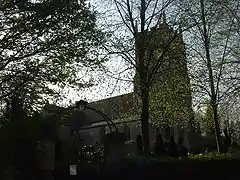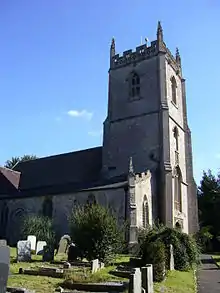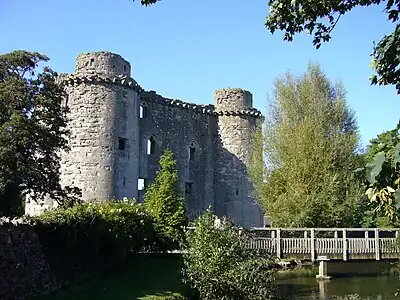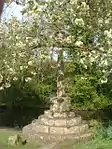Nunney
Nunney is a village and civil parish in the Mendip local government district within the English county of Somerset. It is located 3 miles (5 km) south-west of Frome and the parish includes the hamlet of Holwell.[2]
| Nunney | |
|---|---|
 | |
 Nunney Location within Somerset | |
| Population | 844 (2011)[1] |
| OS grid reference | ST735455 |
| District | |
| Shire county | |
| Region | |
| Country | England |
| Sovereign state | United Kingdom |
| Post town | FROME |
| Postcode district | BA11 |
| Dialling code | 01373 |
| Police | Avon and Somerset |
| Fire | Devon and Somerset |
| Ambulance | South Western |
| UK Parliament | |
The name of the village comes from Old English and means Nunna's island.[3]
Today, the tourist attractions are the ruins of Nunney Castle, a historic church, and ducks wandering the streets near the river. The village hall is host to Nunney Acoustic Cafe which provides live music, homemade food, a bar and children's art activities on the second Sunday of each month (except July and August).[4]
On 30 September 2007, Nunney was the subject of a BBC Radio 4 report, asking whether "the prettiest village in England" is a place where we can learn "how to mend our broken society".[5]
"Visit Nunney" the community interest group closed down in 2021.
History
Evidence of Roman settlement has been provided by the discovery of a hoard of Roman coins in 1869 at Westdown Farm and a villa with a mosaic floor.[3]
Nunney is mentioned as a manor belonging to William de Moyon in the Domesday Book in 1086, but the book does not mention a castle.[6]
The parish was part of the hundred of Frome.[7]
For many years, from the medieval period until the 19th century, Nunney was the site of water-powered mills owned initially by the Hoddinotts and then by James Fussell.[8]
Governance
The parish council has responsibility for local issues, including setting an annual precept (local rate) to cover the council’s operating costs and producing annual accounts for public scrutiny. The parish council evaluates local planning applications and works with the local police, district council officers, and neighbourhood watch groups on matters of crime, security, and traffic. The parish council's role also includes initiating projects for the maintenance and repair of parish facilities, as well as consulting with the district council on the maintenance, repair, and improvement of highways, drainage, footpaths, public transport, and street cleaning. Conservation matters (including trees and listed buildings) and environmental issues are also the responsibility of the council.
The village falls within the Non-metropolitan district of Mendip, which was formed on 1 April 1974 under the Local Government Act 1972, having previously been part of Frome Rural District,[9] which is responsible for local planning and building control, local roads, council housing, environmental health, markets and fairs, refuse collection and recycling, cemeteries and crematoria, leisure services, parks, and tourism.
Somerset County Council is responsible for running the largest and most expensive local services such as education, social services, libraries, main roads, public transport, policing and fire services, trading standards, waste disposal and strategic planning.
The village falls within 'Cranmore, Doulting and Nunney' electoral ward. Starting at Doulting in the west the ward stretches eastwards through Cranmore and Nunney to finish in the east at Whatley. The total ward population taken at the 2011 census was 2,374.[10]
It is also part of the Somerton and Frome county constituency represented in the House of Commons of the Parliament of the United Kingdom. It elects one Member of Parliament (MP) by the first past the post system of election.
Geography
Cloford Quarry is a geological Site of Special Scientific Interest and Geological Conservation Review site important for the exposures of sediments of Triassic and Jurassic age which occur in major fissures within the Carboniferous Limestone laid down beneath the sea some 350 million years ago.[11]
The Holwell Quarries are another geological Site of Special Scientific Interest which represent an internationally important geological locality. A comprehensive assemblage of Triassic (including Rhaetic), Lower Jurassic and Middle Jurassic fissure fillings are well displayed. The Rhaetic fissure fillings have yielded the richest assemblage of vertebrate faunas known from the British Triassic.[12]
Along with the rest of South West England, Nunney has a temperate climate which is generally wetter and milder than the rest of England. The annual mean temperature is about 10 °C (50 °F) with seasonal and diurnal variations, but due to the modifying effect of the sea, the range is less than in most other parts of the United Kingdom. January is the coldest month with mean minimum temperatures between 1 °C (34 °F) and 2 °C (36 °F). July and August are the warmest months in the region with mean daily maxima around 21 °C (70 °F). In general, December is the dullest month and June the sunniest. The south west of England enjoys a favoured location, particularly in summer, when the Azores High extends its influence north-eastwards towards the UK.[13]
Cloud often forms inland, especially near hills, and reduces exposure to sunshine. The average annual sunshine totals around 1600 hours. Rainfall tends to be associated with Atlantic depressions or with convection. In summer, convection caused by solar surface heating sometimes forms shower clouds and a large proportion of the annual precipitation falls from showers and thunderstorms at this time of year. Average rainfall is around 800–900 mm (31–35 in). About 8–15 days of snowfall is typical. November to March have the highest mean wind speeds, with June to August having the lightest. The predominant wind direction is from the south west.[13]
Landmarks
The market cross across the road from the church is Grade II* listed. It was originally built around 1100, when stood in the churchyard of All Saints' Church.[14] It was removed in 1869, as the noise from children playing on the steps annoyed the rector. The stone was discovered in a builders yard and rebuilt in his garden by the squire of Whatley and the Celtic cross added. After his death and a fire which destroyed his house, the cross was again dismantled and rebuilt on its present site in 1959.[15]
There are over 30 other listed buildings in the village, including Rockfield House which was built in 1805 by John Pinch.[16]
Religious sites
The Church of All Saints is a Grade I listed building dating from the 12th century.[17]
Nunney Castle
Nunney Castle is a small, French-style castle surrounded by a deep moat, built for Sir John Delamare in 1373, and said to have been based on the Bastille in Paris, and shows a strong awareness of contemporary French practice.[18] It was later the property of William Paulet, 1st Marquess of Winchester, before passing to several owners and in 1577 was sold by Swithun Thorpe to John Parker who only kept it for a year before selling it to Richard Prater, at a cost of £2000.[19] During the English Civil Wars (1642–51) Colonel Richard Prater, who held the castle until 1645, lost it to Fairfax, the commander of Cromwell's forces in the battle that took place at Nunney. The castle was besieged for two days, but capitulated when Cromwell's men used cannon to blast a great hole in the north west wall of the castle.
The George at Nunney Inn
The George at Nunney Inn is close to the church and opposite Nunney Castle. It dates from the mid-18th century. Since that time it has been much extended and is now a 10 bedroom hotel with holiday cottages. The interior still features many of the original features with stone walls, exposed beams, and large open fireplaces. It is a Grade II listed building.[20]

Nunney Players
The Nunney Players are a Drama group, who meet up every year to put on a performance at the village hall. The Nunney Players have won many awards and have put on shows such as Cinderella, Jack and the Beanstalk and Pinocchio.
Visit Nunney
The village website, run by Visit Nunney community interest company (CIC), was a finalist for UK Information/News Website of the Year in The Good Web Guide Awards in November 2014.[21]
References
- "Nunney Parish". Neighbourhood Statistics. Office for National Statistics. Retrieved 1 January 2014.
- AA Book of British Villages. Drive Publications Limited. 1980. p. 297. ISBN 9780340254875.
- Bush, Robin (1994). Somerset: The Complete Guide. Dovecote Press. p. 159. ISBN 1-874336-26-1.
- "Nunney Jazz Cafe". Nunney Jazz Cafe. Retrieved 24 April 2015.
- report, excerpted from BBC Radio 4 podcast
- Domesday Book: A Complete Translation. London: Penguin, 2003. ISBN 0-14-143994-7 p. 265
- "Somerset Hundreds". GENUKI. Retrieved 8 October 2011.
- Thornes, Robin (2010). Men of iron. The Fussells of Mells. Frome Society for Local Study. ISBN 978-0-9565869-1-9.
- "Frome RD". A vision of Britain Through Time. University of Portsmouth. Retrieved 4 January 2014.
- "Cranmore, Doulting and Nunney ward 2011". Retrieved 7 March 2015.
- English Nature citation sheet for the site . Retrieved 7 August 2006.
- English Nature citation sheet for the site . Retrieved 10 August 2006.
- "South West England: climate". Met Office. Archived from the original on 5 June 2011. Retrieved 14 March 2010.
- Historic England. "Market Cross (1058301)". National Heritage List for England. Retrieved 7 February 2011.
- Byford, Enid (1987). Somerset Curiosities. Dovecote Press. p. 50. ISBN 0946159483.
- Historic England. "Rockfield House (1058309)". National Heritage List for England. Retrieved 7 February 2011.
- Historic England. "Church of All Saints (1058297)". National Heritage List for England. Retrieved 17 May 2009.
- Dunning, Robert (1983). A History of Somerset. Chichester: Phillimore & Co. ISBN 0-85033-461-6.
- Dunning, Robert (2005). A Somerset Miscellany. Tiverton: Somerset Books. p. 22. ISBN 0-86183-427-5.
- Historic England. "George Inn (1174587)". National Heritage List for England. Retrieved 7 February 2011.
- The Good Web Guide Website of the Year Awards 2014 shortlist: Visit Nunney (interview)
- Outline History of Nunney: a brief history of the village and its unusual castle
- Windrum, Anthony. The History of Nunney. ISBN 0-948014-13-X
External links
Gallery of images
 The church
The church Road bridge at Nunney
Road bridge at Nunney View across the footbridge to the church
View across the footbridge to the church The castle
The castle Main street
Main street Market Cross
Market Cross
